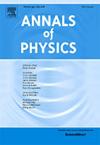后牛顿近似下布朗运动的福克-普朗克方程
IF 3
3区 物理与天体物理
Q2 PHYSICS, MULTIDISCIPLINARY
引用次数: 0
摘要
在后牛顿玻尔兹曼方程的框架内分析了轻气体粒子和布朗重粒子的混合物,以确定布朗运动的福克-普朗克方程。对于每个物种,平衡分布函数是指对应的后牛顿麦克斯韦- j本文章由计算机程序翻译,如有差异,请以英文原文为准。
Fokker–Planck equation for the Brownian motion in the post-Newtonian approximation
A mixture of light-gas particles and Brownian heavy particles is analyzed within the framework of a post-Newtonian Boltzmann equation to determine the Fokker–Planck equation for the Brownian motion. For each species, the equilibrium distribution function refers to the corresponding post-Newtonian Maxwell–Jüttner distribution function. The expressions for the friction viscous coefficient in the first and second post-Newtonian approximations are determined, and we show their dependence on the corresponding gravitational potentials. A linear stability analysis in the Newtonian and post-Newtonian Fokker–Planck equations for the Brownian motion is developed, where the perturbations are assumed to be plane harmonic waves of small amplitudes. From a dispersion relation it follows that: (i) for perturbation wavelengths smaller than the Jeans wavelength two propagating modes – corresponding to harmonic waves in opposite directions – and one mode that does not propagate show up; (ii) for perturbation wavelengths bigger than the Jeans wavelength the time evolution of the perturbation corresponds to a growth or a decay and the one which grows refers to the instability.
求助全文
通过发布文献求助,成功后即可免费获取论文全文。
去求助
来源期刊

Annals of Physics
物理-物理:综合
CiteScore
5.30
自引率
3.30%
发文量
211
审稿时长
47 days
期刊介绍:
Annals of Physics presents original work in all areas of basic theoretic physics research. Ideas are developed and fully explored, and thorough treatment is given to first principles and ultimate applications. Annals of Physics emphasizes clarity and intelligibility in the articles it publishes, thus making them as accessible as possible. Readers familiar with recent developments in the field are provided with sufficient detail and background to follow the arguments and understand their significance.
The Editors of the journal cover all fields of theoretical physics. Articles published in the journal are typically longer than 20 pages.
 求助内容:
求助内容: 应助结果提醒方式:
应助结果提醒方式:


